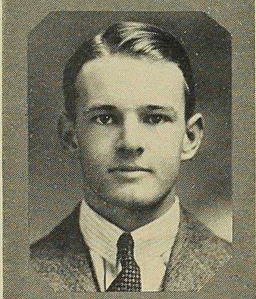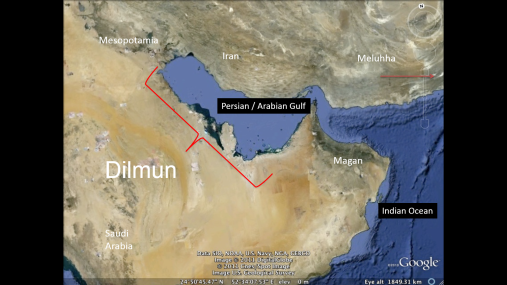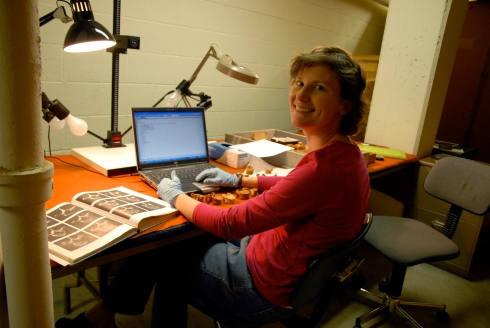Alexis T. Boutin is associate professor of anthropology and coordinator of the cultural resources M.A. program at Sonoma State University. In addition to co-directing the Dilmun Bioarchaeology Project, she is starting a new community-based field project that studies the casualties and legacy of California’s Bear Flag Revolt of 1846. Read more at her Academia.edu page or faculty webpage. When not working or chasing after her children, Alexis spends her free time…actually, she doesn’t have any free time.
Like most good stories, this one starts in an unassuming way: a lone researcher, flipping through yellowed index cards in the wooden drawer of a museum registrar’s card catalog, stumbles across one for human remains from “Saudi Arabia; Bahrein Island”. Casually mentioning the find over lunch with her colleague, who happens to be a curator at the museum, he expresses interest in helping her dig deeper into the collections and archives to find out how these bones came to be in the museum. Thus was born the Dilmun Bioarchaeology Project in late 2008 (Porter and Boutin 2012). The researchers in question are Alexis Boutin, now of Sonoma State University, and Benjamin Porter, of University of California Berkeley. The museum is the Phoebe A. Hearst Museum of Anthropology. The bones, and associated artifacts, belong to the only substantial assemblage from ancient Dilmun in a North American museum. And they have many stories to tell.
Peter Cornwall’s search for Dilmun
We must begin with Peter Bruce Cornwall, the scion of a distinguished family with deep roots in northern California. He found privilege in his education at Andover, Toronto, and Oxford, but was challenged by the deafness that afflicted him late in childhood. As a doctoral student in Anthropology at Harvard, Cornwall’s objective – which his advisor would call a “mania” – was to locate the place named in ancient Near Eastern texts as Dilmun.
Dilmun served as a setting for Mesopotamian creation myths and fantastical events. For instance, the hero Gilgamesh found Utnapishtum there, a former king who was granted immortality after a great flood in a story that mirrors that of the biblical Noah. Dilmun also was well-known as a trading emporium in commercial networks extending to the Ur III societies of Mesopotamia, Magan in Oman, and Meluhha, the Harappan societies of the Indus River Valley. But modern scholars had never agreed upon Dilmun’s actual location or extent.
After overcoming the doubt of his academic advisors at Harvard and eventually winning limited backing from the Hearst Museum, Cornwall sailed for Bahrain in Fall 1940. His journey was made no easier by its route across the Pacific and Indian oceans in the midst of World War II. Cornwall excavated human remains and artifacts from at least 24 tumuli, or burial mounds, on Bahrain, followed by survey and surface collection at 16 or more archaeological sites in eastern Saudi Arabia.
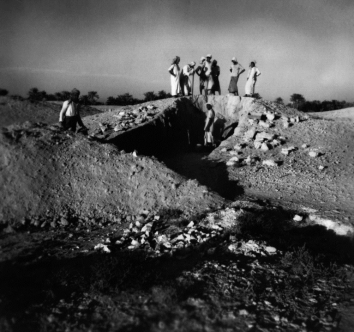
3. Cornwall’s team excavating a tumulus in Bahrain. Courtesy of the Phoebe A. Hearst Museum of Anthropology.
The cost of shipping the finds to his northern California home was covered by the Hearst Museum, in return for their eventual accession there. Cornwall’s analyses allowed him to conclude that Dilmun was a political entity that ran along the eastern edge of the Arabian Peninsula from Kuwait to Qatar and was centered on Bahrain. After publishing his PhD dissertation and several journal articles, Cornwall donated the assemblage to the Hearst Museum as promised in 1945, but provided minimal assistance with its accession. He then began to withdraw from the academic world, moving to Rome and reportedly spending the rest of his days travelling and collecting art and antiquities, before dying in his late 50s of cirrhosis of the liver. Although Cornwall’s contribution to Gulf archaeology has lived on in the works of many others (e.g., Bibby 1970, Crawford 1998, Højlund 2007, Potts 1990), the location of the materials that helped him make this discovery was not known outside of the Hearst Museum.
The Dilmun Bioarchaeology Project
Some 4000 years after these people died and 65 years after their remains were brought to California, Porter and I identified this assemblage (referred to hereafter as the “Cornwall collection”) as a rich source of information about life and death in ancient Dilmun. Although the materials donated by Cornwall had been inventoried during their accession to the Hearst, they had undergone no further systematic analysis since that time. Working with students from Sonoma State and UC Berkeley, we have determined that the Cornwall collection includes over 3,700 objects made from materials including metal, bone, ivory, pearl, shell, and alabaster, although stone and ceramic objects dominate. The datable objects derive mostly from the Early Dilmun period, ca. 2050-1800 BCE. This was a period of unprecedented political and economic prosperity in Dilmun, as suggested by fortified settlements, temple complexes, administrative seals, and imported goods.
When people died in Early Dilmun, their bodies were laid to rest in distinct mortuary monuments that are still visible across the island today. These mounded tumuli usually consist of a stone lined burial chamber covered by a cone of sediments and gravels. In most tombs, one or sometimes two individuals were interred, often in a relaxed fetal position. Surrounding them were ceramic vessels, jewelry, metal weapons, and very rarely alabaster vessels or ivory objects. A sheep or goat might also be included, likely an offering for the deceased to carry into the afterlife. Not all tumuli had the same level of elaborate commemoration. Differences in the size of monuments and the amount and quality of objects indicate that the privileged and wealthy were granted the most elaborate burial conditions.
The human remains in the Cornwall collection represent a minimum of 34 people. Twenty-four adults, as well as one adolescent, were sufficiently well-preserved to permit sex estimation. Nineteen are males/probable males, while six are females/probable females. Of the skeletons for whom an age category could be estimated, the vast majority are adults, with middle adults (35-50 years) being the best represented. However, adolescents, children, infants and one fetus are also present in smaller numbers.
Unfortunately, the notes that Cornwall deposited in the Museum’s accession files are very limited. They contain very few associated field notes, such as photographs of the burials, the position of bodies, and even the geographic coordinates for specific tumuli around the island. We are not sure if Cornwall produced this documentation in the first place, or perhaps he never gave it to the Hearst Museum. We are hopeful that someone will come forward with missing information about Cornwall’s research from a family archive. Nevertheless, important insights can be gained from the Cornwall collection when its contents are analyzed in the context of better-documented research in Bahrain and surrounding regions.
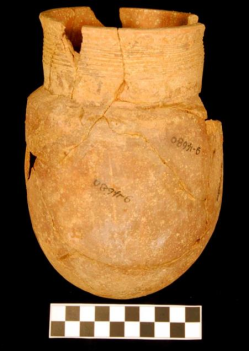
5. Cylindrical wheel-thrown ceramic jar (9-4680) typical of Early Dilmun burial assemblages. Photo by Colleen Morgan. Courtesy of the Phoebe A. Hearst Museum of Anthropology.
Bioarchaeological analysis of skeleton 12-10152 provides a powerful example of one ancient Dilmunite’s experiences in life and death. Cornwall excavated the remains of this person—a male who was at least 60 years old when he died—from a tumulus in the Dar Kulayb mound cemetery near Bahrain’s western coast. No durable objects were buried with him, although multiple bones (including the skull) from a sheep (Ovis aries) or goat (Capra hircus) suggest that he did receive a large portion of a recently butchered animal. The three stories that follow illustrate how bioarchaeological data from one skeleton (here, 12-10152) can be assembled and interpreted in various ways, to tell multiple stories through multiple media.
The Osteological Version
Analysis of 12-10152’s skeleton reveals a long lifetime of physical activity based on degenerative joint disease (DJD) throughout his skeleton. Degenerative joint disease occurs when chronic stress on joints progressively damages articular cartilage and, eventually, underlying bone surfaces. Bone formation and destruction characterize DJD, including the breakdown of articular cartilage, formation of osteophytes at joint margins and entheses, degeneration and consequent porosity of the articular surface, sclerosis, and eburnation caused by direct bone-on-bone contact (Larsen 2015; Ortner 2003). This male’s DJD is more severe in the right shoulder, facet joints of three cervical vertebrae, lower lumbar vertebral bodies, hips, and knees. The degeneration of the right shoulder joint is particularly marked, with significant osteophyte growth on the articular margins of the right humeral head, and extensive eburnation here and on the glenoid fossa of the scapula. Osteophyte formation on the distal femora, more extensive on the left side, indicates degeneration of both knee joints. The articular surface of the left patella (the only one extant) exhibits macroporosity and destruction of the subchondral bone.
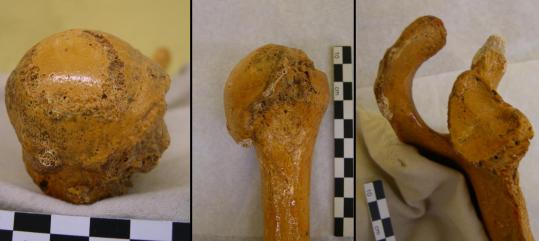
6. Severe degenerative joint disease affecting 12-10152’s right humerus. 6a) eburnation of humeral head (superior view); 6ab) osteophyte growth on margins of humeral head (posterior view); 6c) eburnation of posterior face of glenoid fossa (right scapula, medial view). Photos by the author. (Click to enlarge).
As was common for the elderly of Early Dilmun, this male experienced extensive antemortem tooth loss. His mandible is edentulous, and all but five of his maxillary teeth had fallen out by the time of his death. Moderate DJD of the right temporomandibular joint is evident. The left side is unaffected. Atrophy of the right half of the mandible is also apparent, perhaps caused by a preference for the non-arthritic left side when chewing. In a forthcoming publication, we compare his skeleton with those of two other elderly males in the Cornwall collection to explore how masculinity was embodied in Early Dilmun (Porter and Boutin forthcoming).
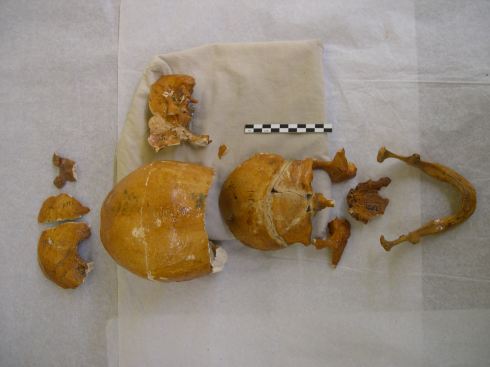
7. Extant cranial skeleton of 12-10152. Note antemortem loss of all teeth in mandible. Photo by the author. (Click to enlarge).
The Visual Version
The comparatively good preservation of 12-10152’s cranial and post-cranial skeleton provided an excellent opportunity to tell his story visually, through a forensic facial reconstruction. This method had already been employed by the Dilmun Bioarchaeology Project on a teenage boy from Early Dilmun with excellent results (Boutin et al. 2012), and we hoped that a facial reconstruction of this older man could provide unique insights about embodied experiences toward the end of life.
Creating a replica of the skull is the first step in facial reconstruction. For 12-10152, whose remains are very delicate and brittle, stereolithography—scanning the skull with lasers to create a digital file—was the best option. Dr. Sabrina Sholts (now of the Smithsonian Institution) obtained multiple scans of each portion of the fragmented skull with a NextEngine 3D laser scanner. After she processed the data on a laptop, the resulting digital files were sent to GoEngineer in Santa Clara, CA, where they were “printed” three-dimensionally in plastic. I brought these plastic cranial bones to the studio of forensic artist Gloria Nusse (San Francisco State University), where she and I worked together to rearticulate them into a model on which the face could be reconstructed.
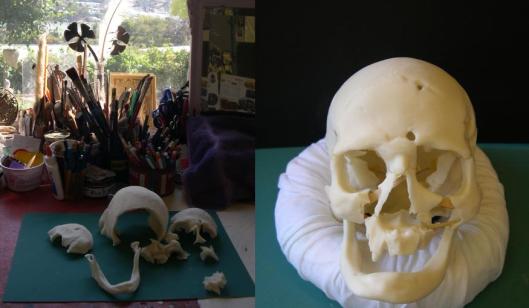
8. Printed components of 12-10152’s skull, before and after re-articulation in Ms. Nusse’s studio. Photos by the author. (Click to enlarge).
When the plastic skull replica was ready, Nusse attached tissue depth markers at standard cranial landmarks. Next, she used oil-based modeling clay to simulate the cranio-facial muscles, with “skin” of the same material eventually added to meet the height of the markers. Once the basic form of the face had been completed, Nusse made small adjustments to the shapes of certain features, such as the eyelids and lips, and used a sponge to texturize the facial skin. She carefully incorporated skeletal features distinct to 12-10152 into his visage: for example, the atrophied and edentulous nature of his mandible gave his lower face a sunken and asymmetrical appearance. Nusse collaborated with Porter and me to create the hair and eye color, hair style, and dress for 12-10152’s reconstruction. Our decisions were informed by texts and iconography from ancient Mesopotamia (which are lacking from early Dilmun), as well as a survey of publicly available photographs of modern Arabian Gulf citizens. The resulting reconstruction has been displayed with that of the teenage boy in an exhibit entitled “From Death to Life in Ancient Bahrain,” which has traveled to several university museums in California.
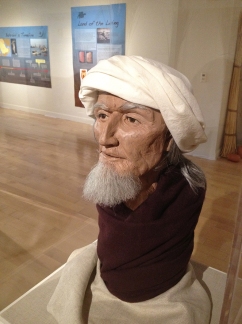
9. Facial reconstruction of 12-10152 by Gloria Nusse, on display at Sonoma State University. Photograph courtesy of Alexis Boutin. (Click to enlarge).
The Narrative Version
The final way that I tell 12-10152’s story is in fictive narrative format, which is informed by the Bioarchaeology of Care and Bioarchaeology of Personhood models. Having described the Bioarchaeology of Personhood in print before (Boutin 2011, 2012), I provide just a few highlights here. Essentially, I have taken Clark and Wilkie’s (2006) concept of an Archaeology of Personhood and adapted it to focus on the relationship between human skeletal remains and embodied experience. These models feature a less ethno- and temperocentric emphasis on individuality than other (bio)archaeological approaches to identity. One of the only constants is the passage of time, which is marked bodily by aging. Although age should not be privileged over other axes of personhood (e.g., gender, class, ethnicity, etc.), it is age that undergirds their fluidity over the life course. So the Bioarchaeology of Personhood attends to the stories that skeletons tell us about how their personhoods were embodied across the life course.
In addition to telling these stories in traditional academic language and scholarly venues, I also write fictive narratives about the skeletons I study. This allows me to draw together socio-historic contextual data, clinical research on health and illness, and bioarchaeological analysis in a way that provides a more humanizing view of past personhoods. But no matter how well-substantiated, these narratives are always the products of my imagination. They could be told in different ways by different authors, depending on which lines of evidence s/he chooses to prioritize. For this reason, the qualifying term “fictive” (after Wilkie 2003) is essential. I have also found the Bioarchaeology of Care (Tilley 2015) to be an extremely useful heuristic tool in creating fictive narratives based on the Cornwall collection. I particularly appreciate how its focus on the provision of health care and support foregrounds the notion of community: each and every life course plays out in concert with those of others to which it is inextricably linked – mothers, husbands, children, neighbors, dynasts, etc. What follows is an excerpt of a fictive narrative about 12-10152’s life course, focusing on the care and support that he may have required during old age.
The heat and dust rose in waves from the road as the young men padded by, their arms full of recently harvested dates. I envied them in more ways than one. “Grandfather, your stew is ready.” It’s been many years since I was able to shimmy up the date palms, let alone chew my favorite date nut treat. But even the few teeth left in my head are enough to enjoy my granddaughter’s fish-and-vegetable stew (as long as she cooks it long enough and I remember to chew on the left side). Finding my walking stick with my left hand and heaving myself up with a grunt, I make my way into the house. A wince and a groan as I raise my right arm to take the bowl from my granddaughter. Ah well – if you live long enough to see your great-grandchildren, some aches and pains are to be expected.
The End
The Dilmun Bioarchaeology Project aims to maximize the interpretive possibilities of the human remains that we have the privilege to study. Telling 12-10152’s story in various ways reminds us that identities are always multi-faceted and that there is no one “right answer” to how bioarchaeological evidence can be interpreted. Another example of this approach can be seen in the multiple stories that we have told about a young woman with disabilities (12-10146) from the Cornwall collection. These include an osteological analysis of her skeletal pathologies (Boutin and Porter 2014), a narrative telling of her embodied experiences in the recent Bioarchaeology of Care session at the 2015 SAAs (with a manuscript in preparation for International Journal of Paleopathology), and a full-body reconstruction by Ms. Nusse planned for 2015-2016. Documentation and analysis of the Cornwall collection will conclude over the next couple of years, with the results to be published in a book entitled Embodying Dilmun: The Peter B. Cornwall Expedition to Eastern Arabia and Bahrain. Will this be the final word on life and death in ancient Dilmun? As the saying goes, the best stories never end.
Bibliography and Further Reading
Boutin, A.T. 2012. Crafting a Bioarchaeology of Personhood: Osteobiographical Narratives from Alalakh. In A. Baadsgaard, A. T. Boutin and J. E. Buikstra (eds.), Breathing New Life Into the Evidence of Death: Contemporary Approaches to Bioarchaeology. Santa Fe: School for Advanced Research Press, 109-133. (Open Access).
Boutin, A.T. 2011. Written in Stone, Written in Bone: The Osteobiography of a Bronze Age Craftsman from Alalakh. In A.L.W. Stodder and A. M. Palkovich (eds.), The Bioarchaeology of Individuals. Gainesville: University Press of Florida, 193-214. (Open Access).
Boutin, A.T. & and Porter, B.W. 2014. Commemorating Disability in Early Dilmun: Ancient and Contemporary Tales from the Peter B. Cornwall Collection. In B.W. Porter and A.T. Boutin (eds.), Remembering the Dead in the Ancient Near East: Recent Contributions from Bioarchaeology and Mortuary Archaeology. Boulder: University Press of Colorado, 97-132.
Boutin, A.T., Nusse, G.L. Nusse, Sholts, S.B. & Porter, B.W. 2012. Face to Face With the Past: Reconstructing a Teenage Boy from Early Dilmun. Near Eastern Archaeology. 75(2): 68-79.
Bibby, G. 1970. Looking for Dilmun. London: Collins.
Clark, B. & Wilkie, L.A. 2006. The Prism of Self: Gender and Personhood. In S. M. Nelson (ed.), Handbook of Gender Archaeology. Lanham, Md.: AltaMira Press, 333-364.
Cornwall, P.B. 1943. The tumuli of Bahrain. Asia and the Americas. 42: 230–234.
Cornwall, P.B. 1944. Dilmun: The history of Bahrein Island before Cyrus. Unpublished Ph.D. dissertation, Department of History, Harvard University.
Cornwall, P.B. 1946. On the location of Dilmun. Bulletin of the American Schools of Oriental Research. 102: 3–11.
Crawford, H.E.W. 1998. Dilmun and its Gulf Neighbours. Cambridge: Cambridge University Press.
Højlund, F. 2007. The Burial Mounds of Bahrain: Social Complexity in Early Dilmun. Moesgaard: Jutland Archaeological Society Publications.
Larsen, C.S. 2015. Bioarchaeology: Interpreting Behavior from the Skeleton. 2nd edition. Cambridge: Cambridge University Press.
Littleton, J. & Frohlich, B. 1993. Fish-eaters and Farmers: Dental Pathology in the Arabian Gulf. American Journal of Physical Anthropology. 92:427-447. (Open Access).
MacLean, R. & Insoll, T. 2011. An Archaeological Guide to Bahrain. Oxford: Archaeopress.
Ortner, Donald J. 2003. Identification of Pathological Conditions in Human Skeletal Remains. 2nd edition. San Diego: Academic Press.
Porter, B.W. & Boutin, A.T. 2012. The Dilmun Bioarchaeology Project: A first look at the Peter B. Cornwall Collection at the Phoebe A. Hearst Museum. Arabian Archaeology and Epigraphy. 23: 35-49.
Porter, B.W. & Boutin, A.T. Forthcoming. The Elders of Dilmun: A Bioarchaeological Analysis of Masculinity from the Peter B. Cornwall Collection. In L. Gregoricka and K. Williams (eds.), Life and Death in Ancient Arabia: Mortuary and Bioarchaeological Perspectives. Gainesville: University Press of Florida.
Potts, D.T. 1990. The Arabian Gulf in Antiquity, Vols. 1 & 2. Oxford: Clarendon Press.
Tilley, L. 2015. Accommodating Difference in the Prehistoric Past: Revisiting the Case of Romito 2 from a Bioarchaeology of Care Perspective. International Journal of Paleopathology. 8: 64-74. (Open Access).
Wilkie, L.A. 2003. The Archaeology of Mothering: An African-American Midwife’s Tale. New York: Routledge.

